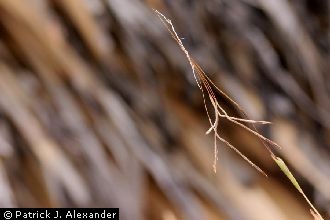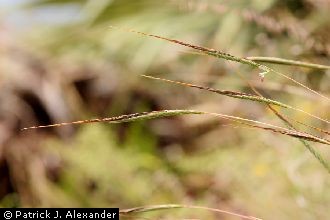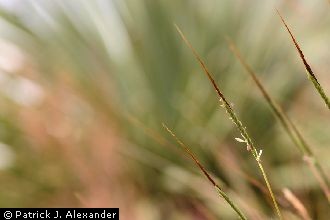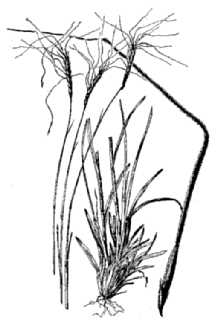Tanglehead
Scientific Name: Heteropogon contortus (L.) P. Beauv. ex Roem. & Schult.
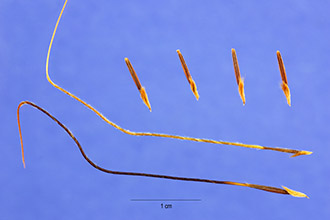
| General Information | |
|---|---|
| Usda Symbol | HECO10 |
| Group | Monocot |
| Life Cycle | Perennial |
| Growth Habits | Graminoid |
| Native Locations | HECO10 |
Plant Guide
Use soil moisture sensors to measure the soil moisture of Tanglehead.
Fact Sheet
Alternate Names
Spear grass, pili, piligrass, twisted beardgrass, lule
Uses
Forage: Tanglehead is a good forage grass for the southwestern United States, and does not develop sharp awns if it is consistently grazed. It is palatable to most livestock during the growing season, but as it matures, it becomes coarser, and loses palatability. Conservation: Primary recommendation for this grass would be vegetation to aid erosion control. Tanglehead also has the potential for ecosystem restoration, re-vegetation of degraded habitats, and to increase diversity in riparian and other communities. Wildlife: Tanglehead can provide good cover for animals and it can also be used as a grass for native habitat restoration projects. Cultural: In ancient Hawaii, tanglehead was used as thatch for houses in drier areas. It was favored because of its pleasant odor and its resistance to weathering. Ornamental: Tanglehead’s interesting looking seedhead makes it a good candidate for ornamental use.
Status
Please consult the PLANTS web site and your State Department of Natural Resources for this plant’s current status (e.g. threatened or endangered species, state noxious status, and wetland indicator values).
Description
Tanglehead is a member of the Andropogoneae tribe of grasses, It is an erect, warm season, perennial that may form rather large bunches reaching heights of 1 to 3 feet tall under natural conditions, Use soil moisture sensors to measure the soil moisture of Tanglehead., At the Hoolehua PMC, under optimum conditions, tanglehead has been known to grow to heights of up to 5 feet tall, There is a wide range of morphological and phenological variations within this species because of its wide range of adaptability, The stems are flattened, rather tough, smooth, and a pale bluish-green, Leaves are produced throughout the length of the stem and are flat or folded, 4-12 inches long, about 0,25 inches wide and rough to the touch, The flowering heads have narrow, crowded flower spikes up to 4 inches long, The spikelets overlap and each fertile one bears a conspicuous red-brown awn about 4 inches long, made crooked with two bends, The long-awned seeds are sharp pointed forming tangled masses as they mature, When the seeds come in contact with moisture, the hygroscopic awns and sharp barbed tips arch and twist planting them into the soil, The species is mostly apomictic (producing seed without pollination), but sexual reproduction has also been known to occur,
Adaptation and Distribution
Distribution
Distribution
Tanglehead has a high degree of adaptability that has allowed it to survive in locations around the world for many years. It can be found on every major landmass between 35º N latitude and 35º S latitude. In Texas, it is found in sandy prairies, the coastal regions, the Trans-Pecos Mountains, and persists in well-managed pastures, although it was once a common grass in the coastal prairies. In Hawaii, tanglehead occurs naturally on all the major islands at sea level to about 2,000 feet elevation and favors dry habitats and rocky cliffs close to the ocean. For a current U.S. distribution map, please consult the plant profiles page for this species on the PLANTS web site.
Establishment
Tanglehead can be reproduced from seeds or vegetative transplants. A stand of tanglehead was established at the Kika de la Garza Plant Materials Center using vegetative bunches split off of mature plants. The seeds have a dormancy period of about 6 months. Although seeds will germinate before this period, the germ-rate will be very low. Studies indicate that this dormancy can be broken with gibberelic acid. Plant propagules in a sterile, well drained medium. Germination should occur within 5-7 days. One week after germination, it is recommended that time-release fertilizer supplements be added. After 2 months, place propagules in full sunlight to harden off. Propagules should be ready to plant within 3-4 months.
Management
Tanglehead is adapted to low rainfall and low fertility soils, although nutrient amendments according to soil tests would be beneficial for rapid establishment. Burning is commonly used as a tool to maintain tanglehead pastures for grazing in other parts of the world. Grazing fields can be shredded or burned on an annual basis to reduce dead plant matter and induce new growth, but burning during the dry season may reduce nutrient availability. On the other hand, some of the south Texas accessions were very sensitive to burning, being slow to re-grow. Therefore, ample time should be given between burning and grazing periods. For rotational grazing, forage height should be utilized between four to ten inches. It is recommended that a minimum six-inch stubble height be maintained under continuous grazing. Tanglehead does not develop seeds if it is consistently grazed, but populations will decrease if grazing is too heavy. Tanglehead can also be harvested as hay-bales containing viable seed, which have been used extensively for the Kahoolawe Island Re-Vegetation Project. Since tanglehead seed-heads have a tendency to bunch-up or tangle when they are mature, harvesting can also be done easily with the ‘PILI COMB’, an implement that was developed at the Hoolehua Plant Materials Center. The use of tanglehead seed bales and seeded hay-bales for re- vegetation of degraded native habitats requires further investigation.
Plant Traits
Growth Requirements
| CaCO3 Tolerance | None |
|---|---|
| Frost Free Days, Minimum | 210 |
| Frost Free Days, Minimum | 210 |
| Fire Tolerance | High |
| Fire Tolerance | High |
| Fertility Requirement | Low |
| Fertility Requirement | Low |
| Drought Tolerance | High |
| Drought Tolerance | High |
| Cold Stratification Required | No |
| Cold Stratification Required | No |
| Temperature, Minimum (°F) | 7 |
| CaCO3 Tolerance | None |
| Anaerobic Tolerance | None |
| Anaerobic Tolerance | None |
| Adapted to Medium Textured Soils | Yes |
| Adapted to Medium Textured Soils | Yes |
| Adapted to Fine Textured Soils | No |
| Adapted to Fine Textured Soils | No |
| Adapted to Coarse Textured Soils | Yes |
| Adapted to Coarse Textured Soils | Yes |
| Hedge Tolerance | None |
| Temperature, Minimum (°F) | 7 |
| Shade Tolerance | Intolerant |
| Shade Tolerance | Intolerant |
| Salinity Tolerance | Low |
| Salinity Tolerance | Low |
| Root Depth, Minimum (inches) | 10 |
| Root Depth, Minimum (inches) | 10 |
| Precipitation, Minimum | 5 |
| Precipitation, Minimum | 5 |
| Precipitation, Maximum | 14 |
| Precipitation, Maximum | 14 |
| pH, Minimum | 6.0 |
| pH, Minimum | 6.0 |
| pH, Maximum | 8.0 |
| pH, Maximum | 8.0 |
| Moisture Use | Low |
| Moisture Use | Low |
| Hedge Tolerance | None |
Morphology/Physiology
| Active Growth Period | Spring and Summer |
|---|---|
| Toxicity | None |
| Toxicity | None |
| Shape and Orientation | Erect |
| Shape and Orientation | Erect |
| Resprout Ability | No |
| Fall Conspicuous | No |
| Foliage Porosity Winter | Porous |
| Foliage Porosity Summer | Moderate |
| Foliage Porosity Summer | Moderate |
| Foliage Color | Green |
| Foliage Color | Green |
| Flower Conspicuous | No |
| Flower Conspicuous | No |
| Flower Color | Yellow |
| Flower Color | Yellow |
| Fire Resistant | No |
| Fire Resistant | No |
| Nitrogen Fixation | None |
| Fall Conspicuous | No |
| Coppice Potential | No |
| Coppice Potential | No |
| C:N Ratio | Medium |
| C:N Ratio | Medium |
| Bloat | None |
| Bloat | None |
| After Harvest Regrowth Rate | Slow |
| After Harvest Regrowth Rate | Slow |
| Active Growth Period | Spring and Summer |
| Resprout Ability | No |
| Foliage Texture | Medium |
| Nitrogen Fixation | None |
| Low Growing Grass | No |
| Low Growing Grass | No |
| Lifespan | Moderate |
| Lifespan | Moderate |
| Leaf Retention | No |
| Leaf Retention | No |
| Known Allelopath | No |
| Known Allelopath | No |
| Height, Mature (feet) | 0.7 |
| Growth Rate | Moderate |
| Height, Mature (feet) | 0.7 |
| Foliage Porosity Winter | Porous |
| Foliage Texture | Medium |
| Fruit/Seed Color | Brown |
| Fruit/Seed Color | Brown |
| Fruit/Seed Conspicuous | No |
| Fruit/Seed Conspicuous | No |
| Growth Form | Bunch |
| Growth Form | Bunch |
| Growth Rate | Moderate |
Reproduction
| Propagated by Cuttings | No |
|---|---|
| Propagated by Seed | Yes |
| Propagated by Seed | Yes |
| Propagated by Sod | No |
| Propagated by Sod | No |
| Propagated by Sprigs | No |
| Propagated by Sprigs | No |
| Propagated by Tubers | No |
| Propagated by Tubers | No |
| Fruit/Seed Persistence | No |
| Seed per Pound | 630000 |
| Seed per Pound | 630000 |
| Seed Spread Rate | Slow |
| Seed Spread Rate | Slow |
| Seedling Vigor | Medium |
| Seedling Vigor | Medium |
| Small Grain | No |
| Small Grain | No |
| Vegetative Spread Rate | None |
| Vegetative Spread Rate | None |
| Propagated by Corm | No |
| Propagated by Cuttings | No |
| Bloom Period | Early Summer |
| Bloom Period | Early Summer |
| Commercial Availability | Contracting Only |
| Commercial Availability | Routinely Available |
| Fruit/Seed Abundance | Low |
| Fruit/Seed Abundance | Low |
| Fruit/Seed Period Begin | Summer |
| Fruit/Seed Period Begin | Summer |
| Fruit/Seed Period End | Fall |
| Fruit/Seed Persistence | No |
| Propagated by Bare Root | No |
| Propagated by Bare Root | No |
| Propagated by Bulb | No |
| Propagated by Bulb | No |
| Propagated by Container | No |
| Propagated by Container | No |
| Propagated by Corm | No |
| Fruit/Seed Period End | Fall |
Suitability/Use
| Palatable Browse Animal | Medium |
|---|---|
| Palatable Graze Animal | Medium |
| Palatable Graze Animal | Medium |
| Palatable Human | No |
| Palatable Human | No |
| Post Product | No |
| Post Product | No |
| Protein Potential | Low |
| Protein Potential | Low |
| Pulpwood Product | No |
| Pulpwood Product | No |
| Veneer Product | No |
| Veneer Product | No |
| Palatable Browse Animal | Medium |
| Nursery Stock Product | No |
| Nursery Stock Product | No |
| Naval Store Product | No |
| Naval Store Product | No |
| Lumber Product | No |
| Lumber Product | No |
| Fodder Product | Yes |
| Fodder Product | Yes |
| Christmas Tree Product | No |
| Christmas Tree Product | No |
| Berry/Nut/Seed Product | No |
| Berry/Nut/Seed Product | No |

